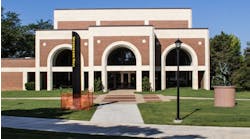With so little time to make that all-important first impression, many colleges and universities see the value of integrated and well-planned environmental graphics systems. They can create a sense of place and extend a school's brand identity throughout the campus. The impact of including this vital element in a campus master plan reaches far beyond those first impressions. Today's comprehensive environmental graphics systems can lead to more cohesive and close-knit college communities, increase recruitment, and build and sustain a strong sense of school identity and spirit.
Environmental graphic design (EGD) typically is defined as “visual communication within the built environment.” An EGD system can include an entire campus signage master plan, as well as individual buildings within a campus such as student centers, halls of fame and sports museums, classroom buildings, dining halls and recreational facilities. Components of the system encompass wayfinding and identity signage, as well as aesthetic components such as banners and media-driven graphics.
The first impression
When prospective students and families visit a campus for the first time, they form indelible impressions within a few minutes. A clear and focused environmental graphics system can have an immediate impact and provide a deliberate path for orientation. Directional signage is a first, all-important welcoming signal. Whether visitors are touring the campus by car or on foot, a wayfinding system that helps with navigation and orientation is vital. University campuses — much like hospital facilities — can be complex places that may leave visitors confused and frustrated.
Schools should approach a signage and wayfinding system as part of the overall visitor experience — helping first-time visitors find their way easily from the area surrounding the campus to the designated parking areas and finally, to specific destinations. If a prospective student becomes lost, especially on a larger campus, frustration sets in. A lost student may no longer view the campus as a welcoming environment. Campus signage should provide clear messages and give assurance that visitors are heading in the right direction.
Bringing the brand to life
Colleges and universities have many ways to develop a strong graphic identity without relying exclusively on mascots and other traditional cues. In creating an effective EGD system, schools must consider the messages that reflect their brands. That might include such themes as a sense of history and tradition, cutting-edge breakthroughs in research and technology, the pride and perseverance of athletic champions, or preparation for leadership and civic commitment. Whether opting for a singular message or a more complex fabric of many diverse messages, environmental graphics can help define, promote, motivate, guide and unify — conveying a high-impact message within a reasonable budget.
Student recreation centers and student unions offer strong opportunities to reinforce the campus brand. These facilities provide the setting for many student activities — serving as a backdrop to lifelong friendships and memories. Schools can nurture a sense of spirit and pride through prominent displays of environmental graphics. Similarly, a performance hall, library, arena or other public venue also may serve as a venue for graphics that convey a comprehensive university experience or philosophy.
The heart of the campus
Many colleges and universities — especially commuter campuses — struggle with the dual challenges of projecting an impressive, high-impact public face while creating a campus environment that provides a sense of intimacy and security. Visual impact and identity on the perimeter of a campus are critical, but it may be even more important to sustain a cohesive, yet vibrant campus core that keeps students focused on their own sense of community.
In an ideal situation, concepts for environmental graphics would be explored in a campus master plan. Administrators also might want to consider the potential for achieving a unified campus core — using a Main Street approach or a central public plaza, green space or block to draw students in and to begin the orientation tour. Environmental graphics — through street and building signage, banners, murals, sculptures, window graphics, lighting and other creative vehicles — can be instrumental in achieving this.
Creating this sense of place through a cohesive environmental graphics system requires close collaboration among the internal school team and the external consultant teams involved in planning and design. Internal school teams may consist of individuals from marketing, recruiting and admissions, operations, facilities, sports and recreation, and campus development. External consultant teams may include the environmental graphics designer, architect, landscape architect, master planner, interior designer and communications specialists. If these teams are working autonomously, it becomes difficult to devise a comprehensive, cohesive program.
All those involved should strive to work hand-in-hand, adjusting as the design philosophy is developed and refined. For example, an environmental graphic designer will have clear ideas on the most efficient campus circulation (vehicular and pedestrian), the location of gateway entries and building/parking adjacencies. To achieve an environmental graphics system that helps optimize the visitor experience — providing clear orientation and communicating a vibrant, welcoming brand message — the EGD consultant should be a part of the work sessions at the onset, in the earliest stages of master planning.
Coss is director of business development with the design firm Gallagher & Associates, Bethesda, Md.



